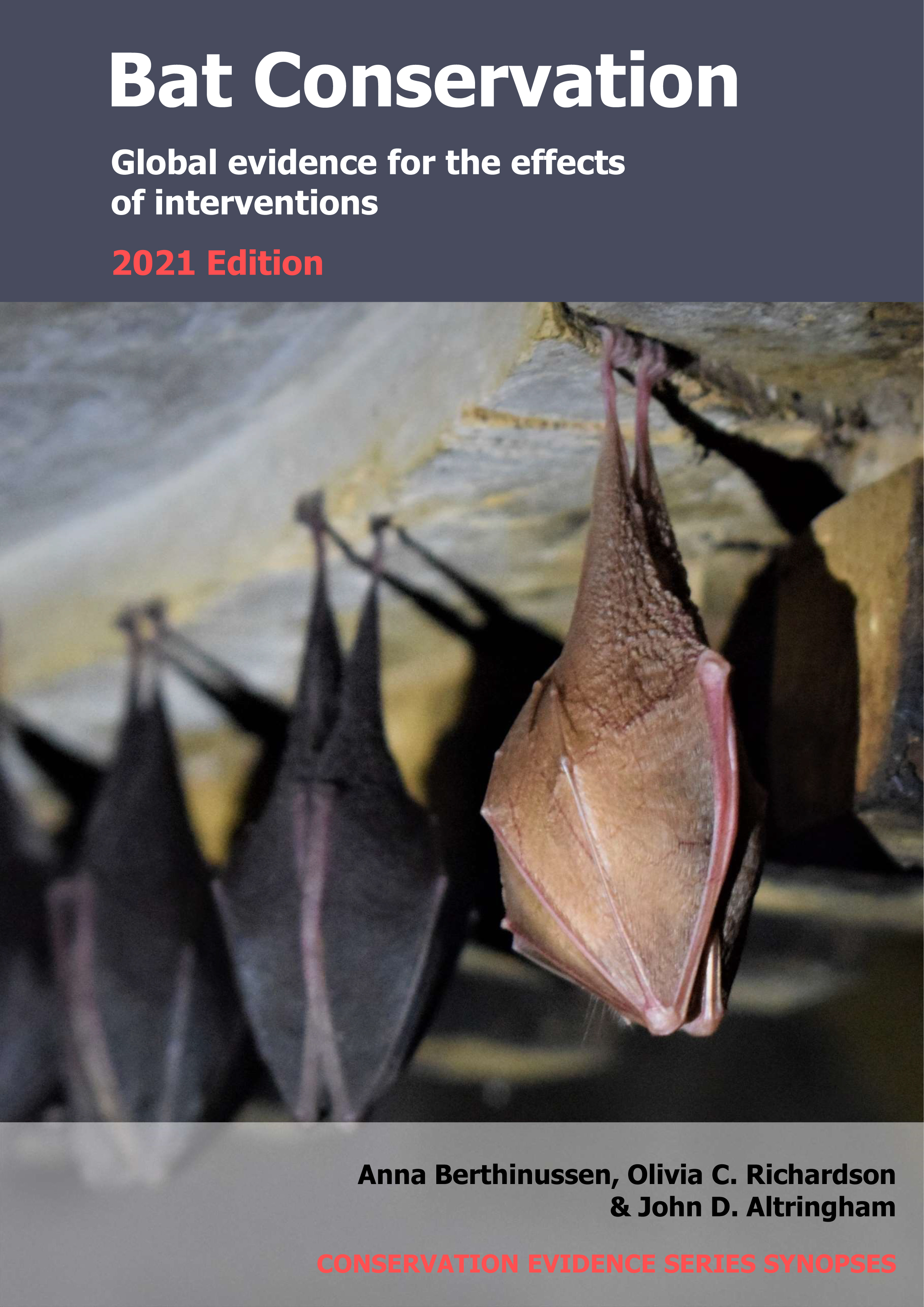Actions to conserve biodiversity
We have summarised evidence from the scientific literature about the effects of actions to conserve wildlife and ecosystems.
Review the evidence from the studies
Not sure what Actions are? Read a brief description.
Search for evidence
e.g. "frogs chytrid"
200 Actions found
Refine
Hide
200 Actions found
Download Actions
| 0 selected |
|
Order results by:
| Action | Effectiveness | Studies | Category | |
|---|---|---|---|---|
|
Minimize road lighting to reduce insect attraction Action Link |
No evidence found (no assessment) | 0 |
|
|
|
Modify bat hibernacula environments to increase survival of bats infected with white-nose syndrome Action Link |
Unknown effectiveness (limited evidence) | 1 |
|
|
|
Modify bats roosts to reduce negative impacts of one bat species on another Action Link |
No evidence found (no assessment) | 0 |
|
|
|
Modify turbine placement to reduce bat fatalities Action Link |
No evidence found (no assessment) | 0 |
|
|
|
Paint turbines to reduce insect attraction Action Link |
No evidence found (no assessment) | 0 |
|
|
|
Pay farmers to cover the costs of conservation measures (e.g. agri-environment schemes) Action Link |
Unlikely to be beneficial | 3 |
|
|
|
Plant field margins with a diverse mix of plant species Action Link |
Unknown effectiveness (limited evidence) | 1 |
|
|
|
Plant gardens with night-scented flowers Action Link |
No evidence found (no assessment) | 0 |
|
|
|
Plant in-field trees Action Link |
No evidence found (no assessment) | 0 |
|
|
|
Plant new hedges Action Link |
No evidence found (no assessment) | 0 |
|
|
|
Plant riparian buffer strips Action Link |
No evidence found (no assessment) | 0 |
|
|
|
Prevent culling of bats around fruit orchards Action Link |
No evidence found (no assessment) | 0 |
|
|
|
Prevent pollution from agricultural land or forestry from entering watercourses Action Link |
No evidence found (no assessment) | 0 |
|
|
|
Prevent pollution from sewage treatment facilities from entering watercourses Action Link |
No evidence found (no assessment) | 0 |
|
|
|
Prevent turbine blades from turning at low wind speeds ('feathering') Action Link |
Beneficial | 6 |
|
|
|
Promote careful bat-related eco-tourism to improve behaviour towards bats Action Link |
No evidence found (no assessment) | 0 |
|
|
|
Protect bats within roosts from disturbance or predation by native species Action Link |
No evidence found (no assessment) | 0 |
|
|
|
Protect brownfield or ex-industrial sites Action Link |
Unknown effectiveness (limited evidence) | 1 |
|
|
|
Protect greenfield sites or undeveloped land in urban areas Action Link |
No evidence found (no assessment) | 0 |
|
|
|
Protect roost trees during forest operations Action Link |
No evidence found (no assessment) | 0 |
|
|
|
Provide alternative bat roosts during maintenance work at road/railway bridges and culverts Action Link |
Unknown effectiveness (limited evidence) | 1 |
|
|
|
Provide artificial subterranean bat roosts to replace roosts in disturbed caves Action Link |
No evidence found (no assessment) | 0 |
|
|
|
Provide artificial subterranean bat roosts to replace roosts in reclaimed mines Action Link |
No evidence found (no assessment) | 0 |
|
|
|
Provide bat boxes for roosting bats Action Link |
Likely to be beneficial | 44 |
|
|
|
Provide or retain set-aside areas in farmland Action Link |
No evidence found (no assessment) | 0 |
|
Download Actions
| 0 selected |
|

Bat Conservation - Published 2021
Update 2020
Watch this search
If you are familiar with RSS feeds, please click the button below to retrieve the feed URL:
RSS feed for this searchIf you are unfamiliar with RSS feeds, we would suggest reading this BBC article.
Unfortunately, due to the number of feeds we have available, we cannot provide e-mail updates. However, you could use tools such as Feed My Inbox to do this for you.
What are 'Individual studies' and 'Actions'?
Individual studies
An individual study is a summary of a specific scientific study, usually taken from a scientific journal, but also from other resources such as reports. It tells you the background context, the action(s) taken and their consequences.
If you want more detail please look at the original reference.
Actions
Each action page focuses on a particular action you could take to benefit wildlife or ecosystems.
It contains brief (150-200 word) descriptions of relevant studies (context, action(s) taken and their consequences) and one or more key messages.
Key messages show the extent and main conclusions of the available evidence. Using links within key messages, you can look at the paragraphs describing each study to get more detail. Each paragraph allows you to assess the quality of the evidence and how relevant it is to your situation.
Where we found no evidence, we have been unable to assess whether or not an intervention is effective or has any harmful impacts.





)_2023.JPG)














